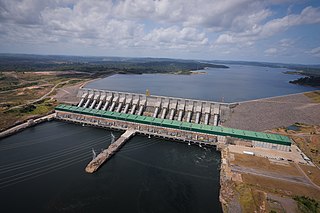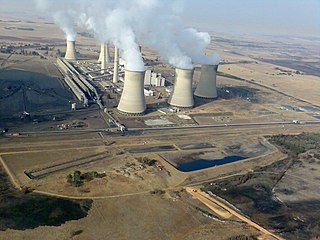Related Research Articles

Bechtel Corporation is an American engineering, procurement, construction, and project management company founded in San Francisco, California, and headquartered in Reston, Virginia. As of 2022, the Engineering News-Record ranked Bechtel as the second largest construction company in the United States.

The Bakun Dam is an embankment dam located in Belaga District, Kapit Division, Sarawak, Malaysia, on the Balui River, a tributary or source of the Rajang River and some sixty kilometres east of Belaga. As part of the project, the second tallest concrete-faced rockfill dam in the world would be built. It is planned to generate 2,400 megawatts (MW) of electricity once completed.
Korea Electric Power Corporation, better known as KEPCO or Hanjeon, is the largest electric utility in South Korea, responsible for the generation, transmission and distribution of electricity and the development of electric power projects including those in nuclear power, wind power and coal. KEPCO, through its subsidiaries, is responsible for 93% of Korea's electricity generation as of 2011. The South Korean government owns a 51.11% share of KEPCO. Together with its affiliates and subsidiaries, KEPCO has an installed capacity of 65,383 MW. On the 2011 Fortune Global 500 ranking of the world's largest companies, KEPCO was ranked 271. KEPCO is a member of the World Energy Council, the World Nuclear Association and the World Association of Nuclear Operators. As of August 2011, KEPCO possesses an A+ credit rating with Fitch Ratings, while Moody's has assigned KEPCO an A1 stable rating.

Run-of-river hydroelectricity (ROR) or run-of-the-river hydroelectricity is a type of hydroelectric generation plant whereby little or no water storage is provided. Run-of-the-river power plants may have no water storage at all or a limited amount of storage, in which case the storage reservoir is referred to as pondage. A plant without pondage is subject to seasonal river flows, thus the plant will operate as an intermittent energy source. Conventional hydro uses reservoirs, which regulate water for flood control, dispatchable electrical power, and the provision of fresh water for agriculture.

Teesside Power Station is a former gas-fired power station, in Redcar & Cleveland, England. Situated near the Wilton chemical complex, the station had combined cycle gas turbines (CCGTs) and open cycle gas turbines (OCGTs), however in 2011 the operation of the CCGT part of the station was suspended, and in 2013 the owners announced its closure and plans to demolish it. Prior to the suspension, the station had a generating capacity of 1875 megawatts (MW), making it the largest of any CCGT power station in Europe. The station could meet almost 3% of the electricity demand for England, Wales and Scotland. Opened in 1993, the station was initially operated by Enron but moved into the hands of PX Ltd after the Enron scandal of 2001, before being bought by Gaz de France and Suez in 2008. The station also worked as a cogeneration plant, providing steam for the Wilton complex.

MAPNA Group is a group of Iranian companies involved in development and execution of thermal and renewable power plants, oil & gas, railway transportation and other industrial projects as well as manufacturing main equipment including gas and steam turbines, electrical generator, turbine blade and vane, HRSG and conventional boilers, electric and control systems, gas compressor, locomotive and other pertinent equipment.

The Belo Monte Dam is a hydroelectric dam complex on the northern part of the Xingu River in the state of Pará, Brazil. After its completion, with the installation of its 18th turbine, in November 2019, the installed capacity of the dam complex is 11,233 megawatts (MW), which makes it the second largest hydroelectric dam complex in Brazil and the fifth largest in the world by installed capacity, behind the Three Gorges Dam, Baihetan Dam and the Xiluodu Dam in China and the Brazilian-Paraguayan Itaipu Dam. Considering the oscillations of flow river, guaranteed minimum capacity generation from the Belo Monte Dam would measure 4,571 MW, 39% of its maximum capacity.
The Siemens Energy Sector was one of the four sectors of German industrial conglomerate Siemens. Founded on January 1, 2009, it generated and delivered power from numerous sources including the extraction, conversion and transport of oil and natural gas in addition to renewable and alternative energy sources. As of October 1, 2014, the sector level has been eliminated, including the Siemens Energy Sector.
STFA Group is one of Turkey’s conglomerates, providing services in the construction, energy distribution, construction equipment and construction chemicals industries. STFA was founded in 1938 by pioneering contractors Sezai Türkeş and Feyzi Akkaya. STFA has experience in 24 countries and a total contract value over US$25 billion.
Sinohydro is a Chinese state-owned hydropower engineering and construction company. In the 2012 Engineering News-Record Top 225 Global Contractors, a ranking by annual revenue, the company is 14th by overall position, and 6th among Chinese construction companies.

Arnot Power Station in Mpumalanga, South Africa, is a coal-fired power plant operated by Eskom. Coal from the Arnot coal mine directly feeds the station.
SEPCO3 is a Chinese construction and engineering company that designs, builds, operates and owns power plants.

The Itumbiara Dam is an embankment dam on the Paranaíba River near Itumbiara in Goiás, Brazil. The dam serves an associated hydroelectric power plant with a 2,082 megawatts (2,792,000 hp) installed capacity. The power plant is the sixth largest in Brazil and has the largest installed capacity of Eletrobrás Furnas' power plants.
The Jirau Dam is a rock-fill dam with an asphalt-concrete core, currently under construction on the Madeira River in the state of Rondônia, Brazil. The dam's hydroelectric power stations will have 50 turbines each 75 MW resulting total installed capacity of 3,750 MW. The power plant's first unit was commissioned in September 2013, the 16th in November 2014, 24th in February 2015, the 41st in December 2015, and the last in December 2016. Most of the power is designed to be exported to south-eastern Brazil via the Rio Madeira HVDC system.
Energy in Sudan describes energy and electricity production, consumption and imports in Sudan. The chief sources of energy in 2010 were wood and charcoal, hydroelectric power, and oil. Sudan is a net energy exporter. Primary energy use in Sudan was 179 TWh and 4 TWh per million persons in 2008.
Mastec, Inc. is an American multinational infrastructure engineering and construction company based in Coral Gables, Florida. The company provides engineering, building, installation, maintenance and upgrade of energy, utility and communications infrastructure. Its customers are primarily in the utility, communications and government industries.
Jharsuguda Power Station is a coal-based thermal power plant located at Burkhamunda near Jharsuguda town in Jharsuguda district in the Indian state of Odisha. The power plant is operated by the Sterlite Energy.
The Nkenda–Fort Portal–Hoima High Voltage Power Line is a high voltage electricity power line, in operation, connecting the high voltage substation at Nkenda, Kasese District, to another high voltage substation at Kabaale, Buseruka sub-county, Hoima District, all in the Western Region of Uganda.
The Tororo–Opuyo–Lira High Voltage Power Line is a high voltage electricity power line, connecting the high voltage substation at Tororo, to another high voltage substation at Lira, in Uganda.

Power Construction Corporation of China, branded as PowerChina, is a wholly State-owned company administered by the State-owned Assets Supervision and Administration Commission and part of the heavy and civil engineering construction industry. PowerChina consists of 779 companies. In 2020, PowerChina ranked 157 among Fortune Global 500 companies and 41 among Top 500 Enterprises of China.
References
- ↑ "The Top 250 Global Contractors". Engineering News Record. 2013.
- 1 2 "SEPCO Announces First Synchronization Of Brazil Candiota Power Plant". ResearchViews. Nov 24, 2010.
- ↑ "Work powers on to hook up new station". African Business Review. 14 Nov 2012.